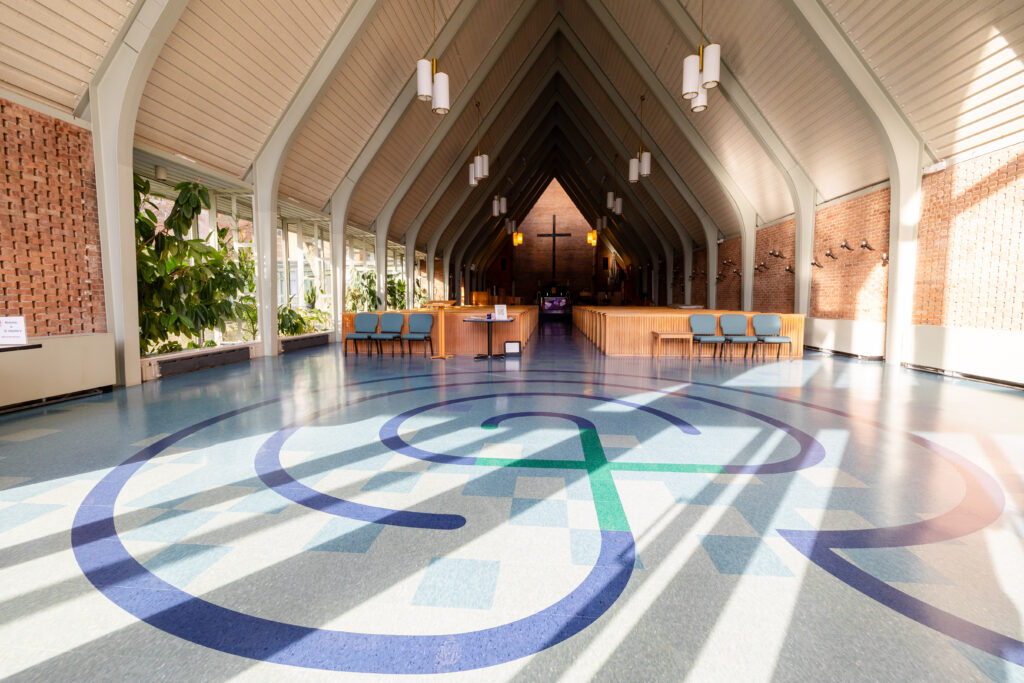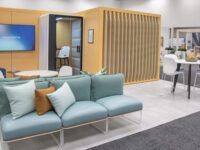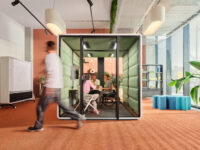Our sensory experiences shape how we think and feel, making thoughtful space curation essential. Beyond simply arranging desks in a collaborative work environment, it involves attention to even the smallest, often-overlooked details to balance functionality, aesthetics, and well-being.
Read on to explore predictions for office design and office furniture trends we anticipate for 2025.
Sensory-Driven Design Trends for 2025
Haworth, a commercial design leader, has identified several sensory design trends that are shaping the future of workspaces. These trends span a wide range of styles and purposes, including:
- Playful Pastels: Embraces individuality with pastel colors and playful, nostalgic elements reminiscent of childhood.
- New Luxuries: Focuses on mindful luxury, prioritizing sustainability and artisanal craftsmanship over materialism.
- The Future is Retro: Draws inspiration from the 1960s space race, combining geometric shapes and AI-generated themes to reflect a utopian vision.
- Natural Organic: Centers on well-being by promoting simplicity, cleanliness, and using non-toxic materials to build trust and support longevity.
- Restorative Spaces: Aims to reduce stress through thoughtful design that caters to physical and mental needs, incorporating soothing colors and textures.
- Under the Sea: Highlights harmony and tranquility with teal-blue hues inspired by water.
Common Themes in Sensory Design Trends
These 6 office design trends may feel as though they have no connection to one another, however, we urge you to take a closer look. Here are just three of the common themes that are laced throughout the above trends impacting the design for the eight senses:
- Color: From aquatic blues to candy-coated pastels, color is a tool to positively promote the visual sense with a low barrier of entry.
- Shape: Influencing your visual, vestibular, and proprioception senses, shape allows you to select the furniture choices, office layout, and design accents that best suit the space and the needs of the team working in it.
- Sustainability: Uniquely influencing each sense, sustainability plays an important role in many of the design trends. Sustainability in office design is frequently overlooked, but choosing to prioritize it can improve your team’s visual, tactile, and interoception experience.
The Role of Sensory-Driven Design in Evolving Workplace Demands
It is clear that the demands of the workplace have evolved greatly over the past five years, evidenced by a complete shift to remote work, transitioning to hybrid workspaces, and recent return-to-office initiatives. Changes like this are cyclical, often caused by the transfer of power between the employer and the employee in the workplace and hiring space.
To avoid having your workplace design become volatile, an emphasis should be placed on the timeless elements of hybrid work models and employee wellness. In the long term, these choices can help your business attract and retain top talent in today’s competitive environment.
Sensory-Driven Design for Hybrid Work & Employee Wellness
Hybrid work models and employee wellness are both positively affected by sensory-driven design elements. Emphasizing these two concepts sets the workplace up for a mutually beneficial relationship between the employee and the employer.
Implementing sensory-conscious design may feel daunting. Below are eight practical steps business leaders can take to incorporate valuable design elements into their workplace today:
- Adjustable lighting in focus spaces
- Provide soundproofing in focus spaces
- Utilize sound masking in collaborative working environments
- Provide privacy pods for independent work and calls
- Incorporate color into spaces depending on the purpose of the space
- Avoidance of confusing, and hard-to-navigate office layouts
- Provide privacy pods for independent work and calls
- Add plants and greenery to take advantage of aquatic and biophilic design
Case Study: Aquatic Inspirations for Tranquility

Sensory-driven design principles extend beyond offices, as seen in religious spaces, where the goal is to create a peaceful, meditative atmosphere for prayer and worship. Two 2025 design trends align with this goal of tranquility, both encouraging harmony and restoration with the use of soothing colors and textures inspired by aquatic environments.
St. Stephen’s Episcopal Church perfectly utilizes color, biophilic elements, and shape to create the desired atmosphere. In addition to the aquatic inspiration, our team at King Business Interiors collaborated with Creative Edge in Iowa to create custom tile shapes with a waterjet cutting service, further utilizing water in this design.
Start Designing for the Senses
In today’s competitive market, prioritizing sensory design is not just a trend—it’s a smart investment in your team’s well-being and productivity. Choose King Business Interiors in Columbus, OH as your trusted design experts. Our team only uses the best of the best, sourcing furniture and flooring from the best business furniture stores near you. Whether you are looking for small office lobby decorating ideas or a complete redesign of your office, our team is ready for the job. Contact us today to get started.



